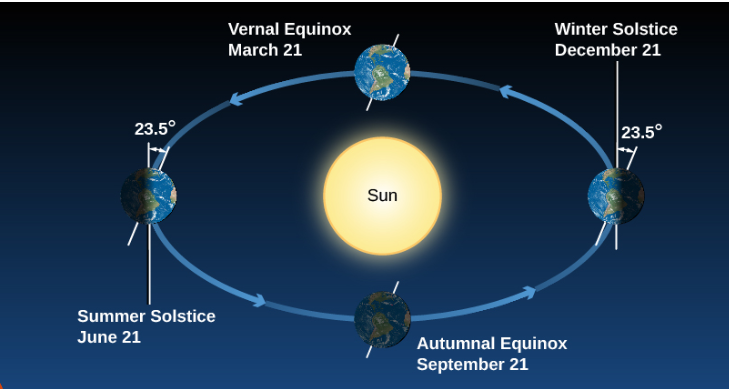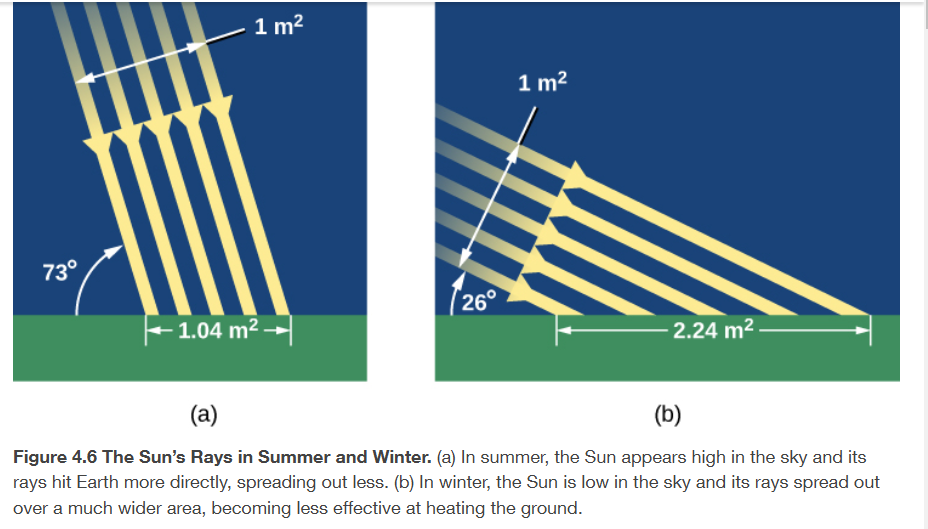chapter 4.2; the seasons & 4.3 keeping time & 4.4 the calendar
1/19
There's no tags or description
Looks like no tags are added yet.
Name | Mastery | Learn | Test | Matching | Spaced |
|---|
No study sessions yet.
20 Terms
seasons
divisions of the year, each with its different amount of sunlight
difference between seasons gets more pronounced the father north or south from the equator
seasons in the Southern Hemisphere are the opposite from the Northern Hemisphere
caused by the 23.5 degree tilt of Earth’s axis
Earth’s titled axis
axis is tilted by 23.5 degrees
Earth’s axis continues to point in the same direction in the sky throughout the year
As Earth travels around the Sun, in June the Northern Hemisphere “leans into” the Sun and is more directly illuminated. In December, the situation is reversed: the Southern Hemisphere leans into the Sun, and the Northern Hemisphere leans away
Spring and Autumn, the Earth leans sideways - the two hemispheres are equally favoured by the Sun


How does the Sun’s favoring one hemisphere translate into making it warmer for us down on the surface of Earth?
when we lean into the Sun, sun light hits us at a more direct angle and is more effective at heating Earth’s surface

increased daylight hours in summer and decreased daylight hours in winter
In June, the Sun is north of the celestial equator and spends more time with those who live in the Northern Hemisphere and vice versa

summer solstice (Northern Hemisphere)
21st June
the Sun shines down most directly upon the Northern Hemisphere of Earth
Sun appears approx. 23 degree north of the equator, therefore passes through the zenith of places on Earth that are at
Sun’s rays shine down all around the North Pole
all places within 23 degrees of the pole will have sunshine for 24 hours
all places within 23 degrees of the South Pole will receive no sunlight (south of the Antarctic Circle)
winter solstice (Northern Hemisphere)
December 21
latitude 23 degrees S, Tropic of Capricorn, the Sun passes through the zenith at noon
Arctic Circle has no sunlight
Antarctic Circle has 24 hours of sunlight
seasons at different latitudes
near the equator; all seasons ae much the same
every day of the year there are approx. 12 hours of sunshine and 12 hours of night
wet and dry seasons
at the North Pole, all celestial objects that are north of the celestial equator are always above the horizon, as Earth turns, circle around parallel to it
the Sun is north of the celestial equator from about March 21 to September 21, so at the North Pole, the Sun rises when it reaches the vernal equinox and sets when it reaches the autumnal equinox
each year there are 6 months of sunshine at each pole, followed by 6 months of darkness
refraction
the bending of light passing through air or water
due to the Earth atmosphere
allows us to see “over the horizon”
Because of this atmospheric refraction (and the fact that the Sun is not a point of light but a disk), the Sun appears to rise earlier and to set later than it would if no atmosphere were present
morning twilight
begins when the Sun is 18 degrees below the horizon
the scatter of light by the atmosphere that occurs even when the Sun is below the horizon
evening twilight
extends until the Sun sinks more than 18 degrees below the horizon
the scatter of light by the atmosphere that occurs even when the Sun is below the horizon
solar day
rotation period of Earth with respect to the Sun
approx. 4 minutes longer than a sidereal day
sidereal day
the rotation period of Earth with respect to the stars
solar day is slightly longer than a sidereal day because Earth not only turns but also moves along its path around the Sun in a day
because our ordinary clocks are set to solar time, stars rise 4 minutes earlier each day
why is a solar day longer than a sidereal day?
Suppose we start when Earth’s orbital position is at day 1, with both the Sun and some distant star (located in the direction indicated by the long white arrow pointing left), directly in line with the zenith for the observer on Earth
When Earth has completed one rotation with respect to the distant star and is at day 2, the long arrow again points to the same distant star
However, notice that because of the movement of Earth along its orbit from day 1 to 2, the Sun has not yet reached a position above the observer
To complete a solar day, Earth must rotate an additional amount, equal to 1/365 of a full turn
The time required for this extra rotation is 1/365 of a day, or about 4 minutes. So the solar day is about 4 minutes longer than the sidereal day.


apparent solar time
time reckoned by the actual position of the Sun in the sky (or, during the night its position below the horizon)
time indicated by sundials
middle of the night as the starting point in each day
during the first half of the day, the Sun has not reached the local meridian (the great circle in the sky that passes through our zenith); before midday (a.m. ante meridiem)
after sun reaches the local meridian (p.m. post meridiem)
exact length of an apparent solar day varies slightly during the year
The eastward progress of the Sun in its annual journey around the sky is not uniform because the speed of Earth varies slightly in its elliptical orbit
Another complication is that Earth’s axis of rotation is not perpendicular to the plane of its revolution
thus, apparent solar time does not advance at the same rate (not a great fundamental unit of time)
mean solar time
based on the average value of the solar day over the course of the year
contains exactly 24 hours and is what we use in our everyday timekeeping
advantage: progresses at a uniform rate
disadvantage: inconvenient for practical use because it is determined by the position of the Sun (e.g. exact time of noon is different as you change longitude)
daylight saving time
local standard time of the place plus 1 hour
prolongs sunlight into evening hours
International Date Line
solution to the following dilemma:
if you advance eastward around the world, every 15 degrees longitude you travel (each time zone), you set your watch an hour ahead
by the time you have completed your trip, you will have gained a day
runs approx. along the 180 degrees meridian of longitude
runs down the middle of the Pacific Ocean
at the date line, the date of the calendar is changed by one day
traditional functions of a calendar
must keep track of time over the course of long spans, allowing people to anticipate the cycle of the seasons and to honour special religious or personal anniversaries
to be useful to a large number of people, a calendar must use natural time intervals that everyone can agree on
defined by motions of Earth, the Moon, and sometimes planets
natural units of our calendar
day: based on the period of rotation of Earth
month: based on the cycle of the Moon’s phases
year: based on the period of the revolution of Earth about the Sun
Julian calendar
introduced by Julius Caesar
year: 365.25 days (actual value is 365.2422)
Gregorian calendar (Pope Gregory XIII)
corrected the issue with the Julian calendar (the true year differs by approx. 11 minutes)
10 days dropped to bring vernal equinox back to March 21
change in rule for the leap year; three of every four century years (leap years under Julian calendar) would become common years; only century years divisible by 400 would be leap years
countries in Eastern Europe did not adopt this calendar until later (Russian Rev dates)